ISSN ONLINE(2278-8875) PRINT (2320-3765)
ISSN ONLINE(2278-8875) PRINT (2320-3765)
| T.Yuvaraja1, A.Lakshminarayanan2, P.Elayaraja3, K.Shajudeen4 Assistant Professor, Dept. of ECE, Kongunadu College of Engineering and Technology, Tamilnadu, India |
| Related article at Pubmed, Scholar Google |
Visit for more related articles at International Journal of Advanced Research in Electrical, Electronics and Instrumentation Engineering
In recent Biometric techniques, Fingerprint Recognition is that the most reliable and wide accepted technique. Native ridge characteristics known as trivialities points represent the fingerprints. The standard strategies haveused this trivialities info solely as some extent set and located out the matched points solely from trivialities sets. As a worldwide feature, orientation field provides strong discriminatory info apartfrom historically usedtrivialities points. So the planned technique describes Associ ate in Nursing Automatic Fingerprint Identification System (AFIS) which includes each native and international option of the fingerprints and operates in 3 stages: (1) trivialities matching (2) reconstructed orientation field matching and (3) Fusion matching. Within the 1st stage, true trivialities points’ are extracted from the input fingerprint image victimization Associate in Nursing improved version of the extraction technique and therefore the matching method is performed. Within the next stage, the fingerprint’s orientation field is reconstructed from the extracted trivialities and additional used within the matching stage. The ultimate stage employs a choice - level fusion matching theme which mixes the reconstructed orientation field matching with the minutiae-based matching. So by victimization this planned theme, performance of the system is increased and higher matching accuracy is obtained than that of victimization typical matching.
Keywords |
| AFIS, Fusion Matching, Field Matching |
INTRODUCTION |
| Biometric authentication devices consider measures that square measure each behavioral and physiological. As each human behavior and physiology amendment over time and assortment setting, biometric characteristics don't seem to be precisely repeatable. |
| A fingerprint refers to the flow of ridge patterns within the tip of the finger. The ridge flow exhibits anomalies in native regions of the tip, and it's the position and orientations of those anomalies that square measure accustomed represent and match fingerprints. Though not scientifically established, fingerprints square measure believed to be distinctive across people, and across fingers of constant individual. Even identical twins having similar polymer, square measure believed to possess completely different fingerprints. Historically, fingerprint patterns are extracted by making an inked impression of the tip on paper. |
| Each and each one among our 10 fingerprints is exclusive, completely different from each {other} and from those of each other person. Even identical twins have distinctive fingerprints. Unlike passwords, PIN codes, and sensible cards that we rely upon nowadays for identification, our fingerprints square measure not possible to lose or forget, and that they will ne'er be purloined. |
a. FINGERPRINTS AS A BIOMETRIC |
| Fingerprints have one in every of the very best levels of reliableness and are extensively utilized by rhetorical consultants in criminal investigations. A fingerprint refers to the flow of ridge patterns within the tip of the finger. |
| The ridge flow exhibits anomalies in native regions of the tip, and it's the position and orientation of those anomalies that area unit wont to represent and match fingerprints. Though not scientifically established, fingerprints area unit believed to be distinctive across people, and across fingers of identical individual. Even identical twins having similarDNA, area unit believed to own completely different fingerprints. Historically, fingerprint patterns are extracted by making associate inked impression of the tip on paper. The electronic era has ushered during a vary of compact sensors that give digital pictures of those patterns. These sensors may be simply incorporated into existing pc peripherals lie the mouse or the keyboard, thereby creating this mode of identification a awfully enticing proposition. This has diode to the augmented use of automatic fingerprint-based authentication systems in each civilian and law-enforcement applications. |
b.FINGERPRINTFEATURE VARIETIES |
| In our hands, fingers, feet, and toes is “ridged” or lined with concentric raised patterns. These ridges square measure known as friction ridges and that they serve the helpful perform of creating it easier to know and hold onto objects and surfaces while not slippage |
| There square measure several variations within the approach friction ridges square measure checkered, broken, and forked that create ridged skin areas, together with fingerprints, unique. Native options create use of 2 kinds of fingerprint characteristics to be used in identification of individuals: international options and native options. The native options also are called trivia Points. They’re the little, distinctive characteristics of fingerprint ridges that square measure used for identification. it's attainable for 2 or additional people to own identical international options however still have totally different and distinctive fingerprints as a result of they need native options – trivia points - that square measure different from those of others. |
LITERATURE SURVEY |
| A.Jain and L.Hong have represented the look associated implementation of an on-line fingerprint verification system. For trivialities matching, associate alignment-based elastic matching formula has been developed [1]. This formula is capable of finding the correspondences between trivialities within the input image and also the hold on guide while not resorting to thorough search and has the power of adaptively compensating for the non linear deformations and inexact cause transformations between fingerprints. A.Jain, S.Prabhakar, and L.Hong have given a Finger Code formula that has reduced the fingerprint matching time for oversized information. However this formula suffers from the necessity that the region of interest be properly set, requiring the correct detection of centre purpose within the fingerprint image. |
| S.Pankanti, S. Prabhakar and A.K.Jain have addressed the matter of fingerprint individuality by quantifying the quantity of knowledge on the market in trivialities options to ascertain a correspondence between 2fingerprint pictures[2]. |
| They need calculable the chance of a false correspondence between trivialities – based mostly representations from 2 discretional fingerprints happiness to totally different fingers[3]. J.Gu, J.Zhou and D.Zhang have established a unique model for the orientation field of fingerprints that has improved the performance of orientation estimation [4]. A Polynomial model was accustomed approximate the orientation field globally and a Point-charge model was used at every singular purpose to boost the approximation regionally. These 2 models were combined along by a weight operate merely known as as combination model. J.Zhou and J.Gu have planned a model-based technique for the computation of orientation field[5]. |
| The coarse field was computed by mistreatment the Gradient-based formula. J.Qi, S.Yang and Y.Wang have outlined a unique feature vector for every fingerprint item supported the world orientation field [6]. These options wereaccustomed establish corresponding trivialities between 2 fingerprint impressions by computing the Euclidian distance between vectors[7]. J.Gu, J.Zhou and C.Yang have planned a unique illustration for fingerprints that has enclosed each trivialities and model-based orientation field.A.Ross, J.Shah, A.K.Jain have showed that 3 levels of knowledge concerning the parent fingerprint can be induced from the trivialities guide alone, viz., 1) the orientation field data 2) the category or kind data and 3) the friction ridge structure [8]. |
PROPOSED SCHEME IN FINGERPRINT RECOGNITION SYSTEM |
a. OVERVIEW OF PROPOSED SCHEME |
| A Decision-Level fusion matching theme is projected to boost the minutiae-matching accuracy in automatic fingerprint recognition system. The most plans are reconstructing fingerprint’s orientation field from trivialities and any utilizing it within the matching stage to boost the performance of the system. The projected combination model consists of a series of matching stages. A grey level fingerprint image is taken into account to check this fusion theme. The primary stage is that the extraction of trivialities templates from the input fingerprint image. Trivialities extraction is simply a crucial task of extracting singular points during a weakened ridge map. AN improved version of physicist filter formula has been used for extracting true trivialities points. |
| Following step is to estimate the effective region by solely victimization trivialities info, the ridges and valleys. Effective region are often calculable by fining the tiniest envelope that contains all the trivialities points. Following method is that the reconstruction of orientation field from trivialities. Interpolation-Model primarily based technique has been used for reconstruction. After that, the reconstructed orientation field is employed into the matching stage. |
| If the matching score is more than an exact threshold, we area unit saying the 2 orientation fields are matched. So this fusion matching theme is that the combination of reconstructed orientation field matching and also the standard minutiae-based matching. The ultimate matching score is that the summation of variety of matched trivialities pairs and also the similarity degree of orientation fields. |
ESTIMATION OF EFFECTIVE REGION |
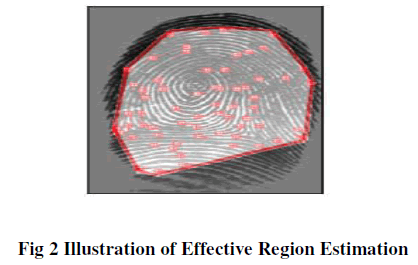 |
| Fig 2 shows about solely having trivialities feature, we are able to extract the effective region by solely mistreatment trivialities info however the ridges and valleys. During this state of affairs, we are able to extract the effective region by finding the littlest envelope that contains all the trivialities points. |
b.INTERPOLATION |
| The trivia of a fingerprint perpetually distribute “no uniformly,” which ends up in some distributed regions wherever there area unit few trivia. So as to relinquish high weights to the trivia within the distributed space. |
| We tend to turn out “virtual” trivia by victimization interpolation before modeling. Since the orientation field of fingerprints perpetually modification swimmingly, it's attainable to estimate the direction of a degree by examining the direction of trivia points within the native region. So as to interpolate “virtual” trivia within the distributed space, we decide 3 trivia points to construct a triangle. |
c. GENERATION OF VIRTUAL MINUTIAE |
| Let P (x, y) denotes the “virtual” trivia placed within constellation, Δ M1 M2 M3, di = || P-Mi || be the Euclidian distance of those “virtual” trivia from the ith vertex Mi. And let θi be the direction corresponds to the vertex, Mi. it’s clear that a vertex ought to have an effect on additional on the “virtual” trivia P if it's nearer to P than alternative vertex. |
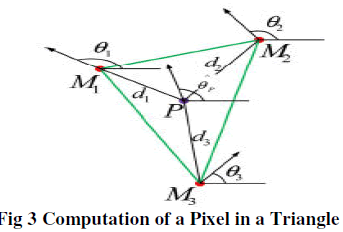 |
| A Decision-Level fusion matching theme is planned to boost the minutiae-matching accuracy in automatic fingerprint recognition system. The most plans is reconstructing fingerprint’s orientation field from trivia and more utilizing it within the matching stage to boost the performance of the system. The planned combination model consists of a series of matching stages. |
RESULTS AND DISCUSSION |
| In performance analysis of this fingerprint information of FVC2004 is taken into account to ascertain the bottom truth of the trivialities. Fig 2 experiments area unit distributed to check the performance of the system. In Fig 3,4 the planned theme is applied to fingerprint pictures and also the matching accuracy is evaluated. The second experiment is that the comparison of the planned methodology with existing methodology. |
d. PERFORMANCE EVALUATION |
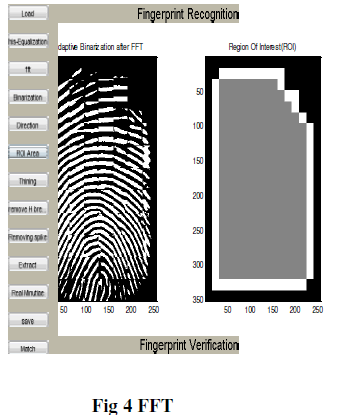 |
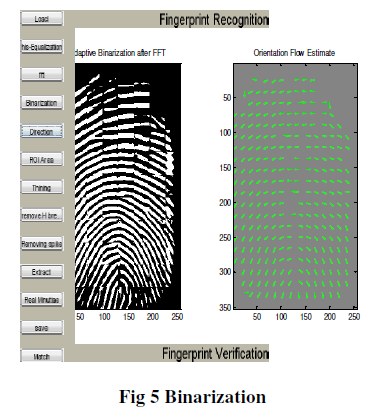 |
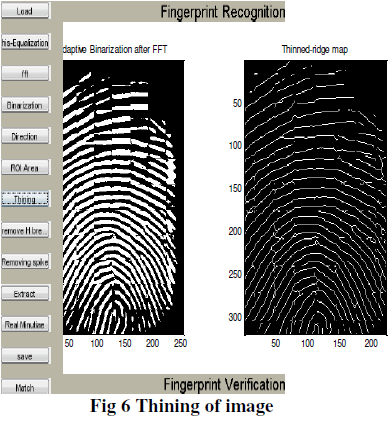 |
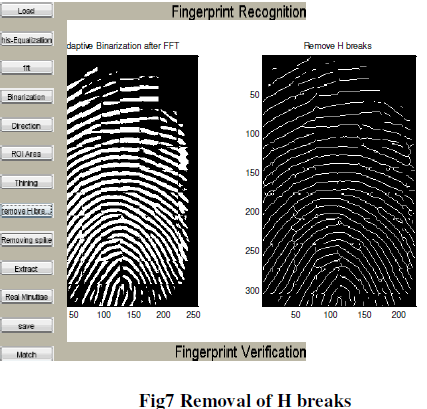 |
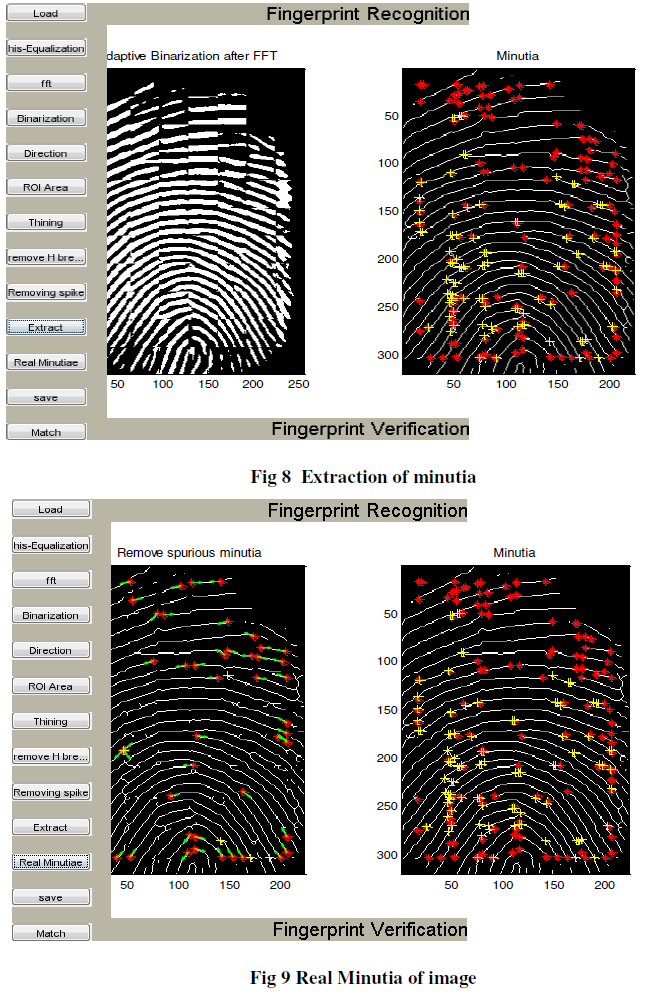 |
| The final steps given in figure 8and 9 is shows that the fusion matching theme that is that the combination of reconstructed orientation field matching with the traditional trivia - based mostly matching. If the quantity of trivia and also the orientation field area unit matched with each other, then the image is claimed to be a Recognized Image. Similarly, if they’re not matched with each other, then the image won't be recognized. |
COMPARISON WITH EXISTING METHODOLOGY |
| As associate example, in Fig. 6, there's a trivialities M whose direction is calculable wrong, and Fig. 7 shows the corresponding poor result by interpolation. IM methodology will take into account all of the trivialities data, that the impact of the incorrect direction of M may be reduced by alternative correct trivialities. Thus, exploitation the planned methodology to reconstruct orientation field will overcomes the matter iatrogenic by M to some extend by adding some positive contribution of alternative trivialities. Fig. 8 shows the orientation field reconstructed supported IM methodology which might overcome the matter iatrogenic by the wrong calculable trivialities M. |
| The typical ways have used the trivialities info solely as a degree set, the parameter choice strategy is totally image dependent that ends up in artifacts in some cases and also the results square measure unacceptable. Conventional Image sweetening technique isn't consistent. Time and memory intense. |
| After the interpolation, the minutiae distribute “uniformly”. With this improvement, the model-based method can get a better performance as show in fig 10 (c). |
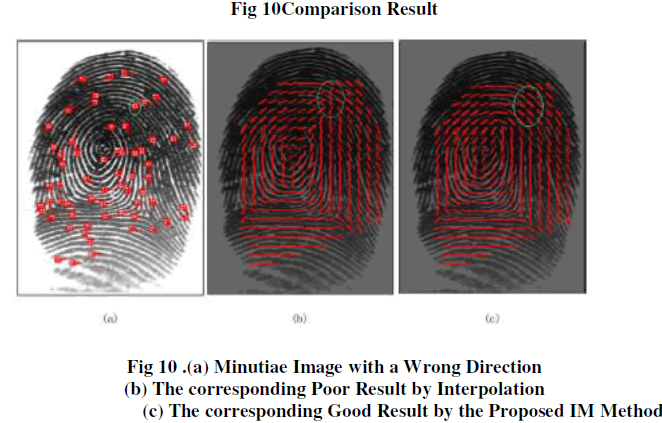 |
a.Deserves of planned theme |
| Matching accuracy will be greatly improved by exploitation Fusion matching theme. Improves the performance of orientation, estimation.More correct and strong with relevancy noise.Feasible to use orientation info within the matching method. Extraction of true trivialities consequently ends up in a rise within the dependableness of the automated fingerprint identification system. The extracted options square measure freelance of shift and rotation of the fingerprint. Parameter choice strategy is totally image freelance. Improves the distinction between ridge and natural depression structures within the input fingerprint pictures. Ease of process. |
CONCLUSION |
| Thus a quick and sturdy approach to fingerprint recognition has been planned to obtain the optimized solution. Orientation field is very important for fingerprint illustration. So as to utilize the orientation data in automatic fingerprint recognition system that solely stores trivialities feature, a completely unique technique has been planned to utilize the trivialities for fingerprint recognition. |
| The reconstructed orientation field data has been used into the matching stage. The planned rule combines the interpolation technique and model-based technique to reconstruct orientation field, and reduces the result of wrong detected trivialities. Conjointly an additional precise trivialities extraction method has-been enforced, reducing consequently the generation of spurious trivialities. Many economical preprocessing techniques are developed to boost the skeleton image for trivialities extraction. Actuality trivialities area unit preserved and therefore the false trivialities area unit removed in later post process stage. As a result, the planned technique features a higher performance on hardiness, accuracy and conjointly machine quality for orientation field estimation has been reduced as compared to trivialities - primarily based approach. |
References |
|